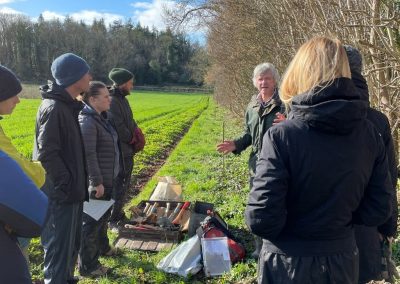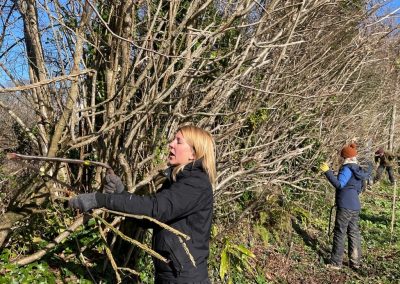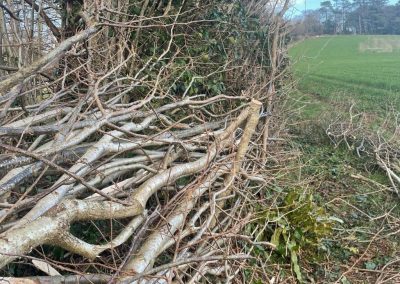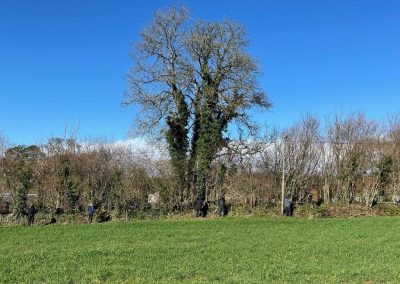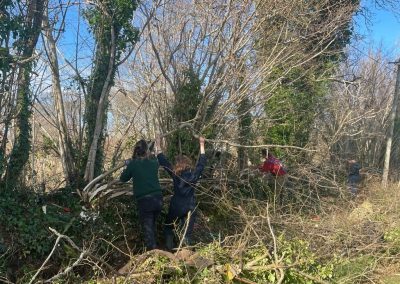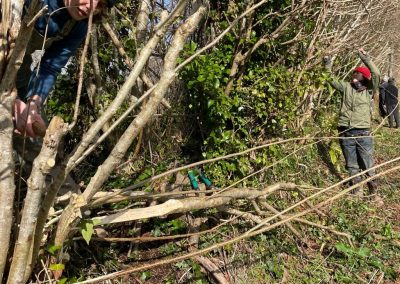Perspectives on hedgelaying as a learning process
This week our Regenerative Food, Farming and Enterprise MSc students have been learning all about the time-honoured practice of hedgelaying, and in this blog post Will Kemp explores how the traditional act of laying a hedge might be compared to the transformative learning process more generally.

Students learning by doing out in the field
This week our MSc Regenerative Food, Farming and Enterprise students have been learning all about the time-honoured practice of hedgelaying. We had a theory session on Wednesday looking at the astonishing history of hedgelaying in Britain, and in Devon in particular, where on Dartmoor some living hedges have been identified as having existed continuously for well over three thousand years. We also explored the remarkable biodiversity that the English hedgerow encourages, providing habitat for a great number of native species. This indoor session was then followed up by two days of practical hedgelaying led by one of the leading authorities on Devon hedgelaying, Tom Hynes of Devon Hedge Group. Amid very changeable weather conditions, the students laid a hedge on the edge of the largest agroforestry field here on the Dartington estate, known as Broadlears.
While they were at work, it occurred to me that the practice of hedgelaying works as an analogy for the kind of transformative learning experience all our courses aim to provide for our students.
The first stage of hedgelaying (once you have scoped out an appropriate hedge) is the partial cutting of the trees that have grown up, known as steeping in Devon (pleaching elsewhere). This involves splitting the narrow trunk in order to bend the trees down so that they are still alive but can be laid horizontally. I thought this might represent the step a student makes in giving up other things in their life to commit to come and study at Dartington. Similarly there is the process of clearing the way, or disentangling the branches above, in order for the first small tree to fall to the ground, perhaps further extending this aspect of finding time and space to study.
The heel is the part of the tree that remains pointing upwards once the main part has come down, which has to be sawn off, though without breaking the connection between the roots and the steeper. Is this in some respect the preconceptions of the student being cast off?
Then comes the process of holding in place all the horizontal steepers. In Devon hedges these are held in place by crooks, which are forked sticks, or stubs of branches coming off the main trunks of the steepers. This could be compared to the teaching sessions of our courses, as lecturers and tutors help students hold fast to the new perspectives, mindsets, or practical knowledge that is offered to them.
Once these are in place and all the steepers are held down by the crooks, the work is done, and over time the horizontal steepers, which are still living trees, will begin to shoot up multiple new vertical branches. Again the comparison seems to work with transformative learning, if we think of the student as having changed in such a way by their experience that they are now able to follow multiple lines of enquiry in a more nuanced, ecologically sensitive way. Where before were thicker trunks of trees with quite a bit of unwanted space in between, now there is potential for a much fuller hedge of diverse growth, where thousands of species of insects and other creatures can live and thrive.
A final point on this extended analogy… One further hedgelaying practice which is quite unique to Devon is what’s known as casting up. Here, the dislodged or eroded soil that has fallen away from the hedge during the process of hedgelaying (and through the vicissitudes of time) is put back, literally “cast up”, onto the top of the hedge. This helps maintain the height of the main structure, but it also turns things upside down, the soil is now high up at the top, as well as in its usual place on the ground. In the regenerative approaches we teach at Schumacher College, the wellbeing of the soil around us is one of the most fundamental concerns, so the literal parallel here of the soil above and below, extends to a more general idea, as argued by Satish Kumar, that soil and society are intrinsically linked.
We also teach our students how to turn the things they are studying upside down, to look at them from new or alternative perspectives, often outside of or in contrast to the generally accepted, or mainstream view. The value of this is that once we have done it we can more effectively evaluate what is going on in the world, as we begin to turn what might be seen as intellectual boundaries, lines of limitation, or closed gates and doors, into porous, living, liminal spaces, creating open thresholds for ecological thinking and new ideas to flourish. From this vantage point students during and towards the end of their course can begin to decide for themselves more clearly which actions they might take to make the world a better place.
Come and join us on the other side of the hedge!
Applications are now open via UCAS for our undergraduate programme, the BSc Regenerative Food and Farming at Schumacher College, starting in September 2022. We are also accepting applications for the next iteration of the MSc Regenerative, Food, Farming and Enterprise which begins in January 2023. Find out more and apply via the buttons below.

